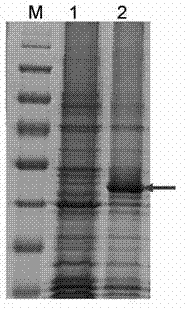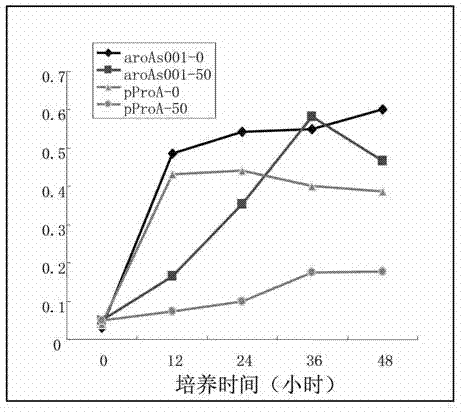Gene aroA for encoding 5-enolpyruvyl-shikimate-3-phosphate synthase and application thereof
A technology of pyruvyl shikim and phosphate synthase, which can be used in application, genetic engineering, plant genetic improvement and other directions, and can solve problems such as low glyphosate resistance
- Summary
- Abstract
- Description
- Claims
- Application Information
AI Technical Summary
Problems solved by technology
Method used
Image
Examples
Embodiment 1
[0021] The screening and isolation of highly glyphosate-resistant strains is to take soil samples from vegetable fields in Guangdong and use glyphosate as a screening marker to isolate and obtain Klebsiella pneumoniae kpS001 strains; specifically, the following steps are included:
[0022] 1. Isolation of Klebsiella pneumoniae highly resistant to glyphosate:
[0023] (1) Take 10 g of vegetable field soil samples in Guangdong, add them to 90 mL of 150 mmol / L glyphosate (original powder) basal salt medium (liquid), and culture them at 37 °C and 120 r / min for 72 h.
[0024] (2) Take 10mL of the culture solution from step (1) and add it to the basal salt medium (liquid) containing 200mmol / L glyphosate (original powder) for cultivation, and cultivate at 37°C and 120r / min for 72h; and so on, the previous Add 300, 350, 400mmol / L glyphosate (raw powder) to the basal salt medium (liquid) step by step in the round culture solution, and cultivate at 37°C and 120r / min for 72h.
[0025] (...
Embodiment 2
[0039] Cloning the gene aroA encoding Klebsiella pneumoniae EPSP synthetase, the present embodiment utilizes the method of homologous cloning to clone the gene aroA encoding EPSP synthetase from bacterial strain kpS001; Specifically comprises the following steps:
[0040] 1. Genome extraction method of Klebsiella pneumoniae kpS001 strain: Genome extraction is extracted with the Genome Extraction Kit of Tiangen Bacteria. The operation steps are basically the same as the instruction manual, with slight modifications as follows:
[0041] (1) Take 2 mL of bacterial culture solution, centrifuge at 12,000 rpm for 1 min, and suck up the supernatant as much as possible.
[0042] (2) Add 200 μL buffer GA to the cell pellet and shake until the cell is completely suspended.
[0043] (3) Add 20 μL proteinase K solution to the tube and mix well.
[0044] (4) Add 220 μL buffer GB, shake for 15 seconds, and place at 70°C for 10 minutes. After the solution becomes clear, briefly centrifuge t...
Embodiment 3
[0086] build aroA S001 The recombinant vector with the prokaryotic expression vector pProA comprises the following steps:
[0087] 1PCR amplification
[0088] According to the sequencing results of Example 2 (SEQ ID NO.3), the primers were redesigned as follows:
[0089] KpF1: 5-GAATTCATGGAATCCCTGACGTTACAAC-3
[0090] KpR1: 5-CTCGAGTCAGGCGAGGGTACTGATCCG-3
[0091] PCR reaction system:
[0092] 10*Taq buffer 3μL dNTPs (10mmol) 1μL kpF (10pmol) 1μL kpR (10pmol) 1μL dna 2μL rTaq 0.3μL wxya 2 o 21.7μL Total 30μL
[0093] The PCR reaction procedure is as follows:
[0094] 94℃ 5min
[0095]
[0096] 72°C 10min
[0097] 16℃Forever
[0098] After the PCR product was electrophoresed on a 1% agarose gel, the target fragment was recovered with the Tiangen DNA Product Rapid Purification and Recovery Kit, with a length of about 1300bp. Ligated to pMD18-T vector. The recombinant vector was transformed into Escher...
PUM
 Login to View More
Login to View More Abstract
Description
Claims
Application Information
 Login to View More
Login to View More - R&D
- Intellectual Property
- Life Sciences
- Materials
- Tech Scout
- Unparalleled Data Quality
- Higher Quality Content
- 60% Fewer Hallucinations
Browse by: Latest US Patents, China's latest patents, Technical Efficacy Thesaurus, Application Domain, Technology Topic, Popular Technical Reports.
© 2025 PatSnap. All rights reserved.Legal|Privacy policy|Modern Slavery Act Transparency Statement|Sitemap|About US| Contact US: help@patsnap.com



